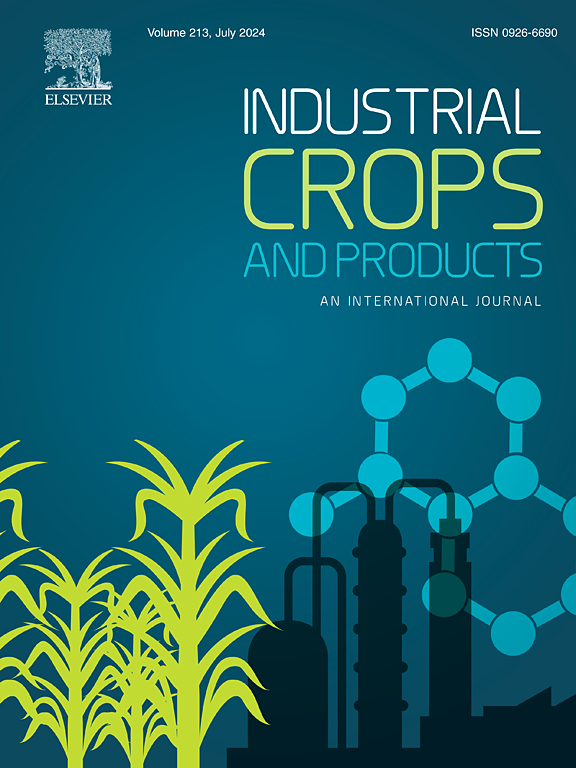纳米银/碱性木质素/再生纤维素纤维织物的防紫外线和抗菌性能
IF 6.2
1区 农林科学
Q1 AGRICULTURAL ENGINEERING
引用次数: 0
摘要
再生纤维素纤维(如粘胶纤维、莫代尔纤维)和天然棉纤维由于其固有的柔软性、透气性和吸湿性,在夏季纺织品生产中仍然占主导地位。然而,它们有限的抗紫外线能力和对微生物定植的倾向限制了它们的扩展应用。为了解决这些限制,我们通过湿纺方法开发了一种新型的再生纤维素基复合纤维,其中包含银纳米粒子(AgNPs)和碱性木质素(AL)。合成工艺是将AL和棉纤维素(CC)溶解在N,N-二甲基乙酰胺/氯化锂(DMAc/LiCl)溶液中,然后进行湿纺丝制备AL/CC纤维。随后,AgNPs在AL/CC-g纤维表面原位合成,得到Ag/AL/CC-g纤维。通过XPS、SEM、DSC、TG等表征了Ag/AL/CC-g纤维的结构、化学成分和热稳定性。Ag/AL/CC-g纤维具有良好的抑菌活性,对大肠杆菌和金黄色葡萄球菌的抑菌率均达到>; 99.99 %。研究了Ag/AL/CC-g纤维织成的Ag/AL/CC-g织物的防紫外线性能,揭示了AL含量与紫外线吸收的直接关系。值得注意的是,Ag/AL/CC-g织物(含46 % AL和7 % AgNPs)显示出“卓越”的紫外线防护,UPF值超过40,根据欧洲标准(EN 13758-2)。本研究提出了一种新颖有效的方法来制造纤维素基纺织品,具有增强的抗紫外线和强大的抗菌性能的双重功能,扩大了它们在高性能夏季服装和医用纺织品中的潜在应用。本文章由计算机程序翻译,如有差异,请以英文原文为准。
Ultraviolet protection and antibacterial properties of textile fabric made of silver nanoparticles/alkaline lignin/regenerated cellulose fiber
Regenerated cellulose fibers (e.g., viscose, modal) and natural cotton fibers remain dominant in summer textile production owing to their inherent softness, breathability, and moisture absorption. Nevertheless, their limited ultraviolet (UV) resistance and proneness to microbial colonization restrict extended applications. To address these limitations, we developed a novel regenerated cellulose-based composite fiber incorporating silver nanoparticles (AgNPs) and alkaline lignin (AL) through a wet-spinning approach. The synthesis process involved dissolving AL and cotton cellulose (CC) in an N,N-dimethylacetamide/lithium chloride (DMAc/LiCl) solution, followed by wet spinning to produce AL/CC fibers. Subsequently, AgNPs were in situ synthesized on the surface of the AL/CC-g fibers, resulting in Ag/AL/CC-g fibers. The structural, chemical composition, and thermal stability of the Ag/AL/CC-g fibers were characterized through XPS, SEM, DSC, TG. The Ag/AL/CC-g fibers exhibited good antibacterial activity, achieving a > 99.99 % reduction rate against both E.coli and S.aureus. The UV-blocking capability of Ag/AL/CC-g fabric (woven from Ag/AL/CC-g fibers) was evaluated, revealing a direct correlation between AL content and UV absorption. Notably, the Ag/AL/CC-g fabric(with 46 % AL and 7 % AgNPs) demonstrated “excllent” UV protection, achieving a UPF value exceeding 40, according to the European standard(EN 13758–2).This study presents a novel and effective approach to fabricating cellulose-based textiles with dual functionality—enhanced UV resistance and robust antibacterial properties—expanding their potential applications in high-performance summer apparel and medical textiles.
求助全文
通过发布文献求助,成功后即可免费获取论文全文。
去求助
来源期刊

Industrial Crops and Products
农林科学-农业工程
CiteScore
9.50
自引率
8.50%
发文量
1518
审稿时长
43 days
期刊介绍:
Industrial Crops and Products is an International Journal publishing academic and industrial research on industrial (defined as non-food/non-feed) crops and products. Papers concern both crop-oriented and bio-based materials from crops-oriented research, and should be of interest to an international audience, hypothesis driven, and where comparisons are made statistics performed.
 求助内容:
求助内容: 应助结果提醒方式:
应助结果提醒方式:


